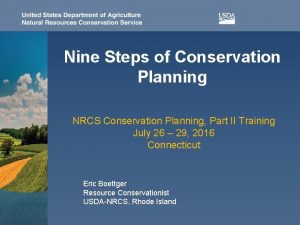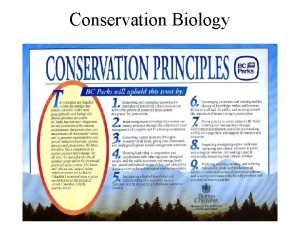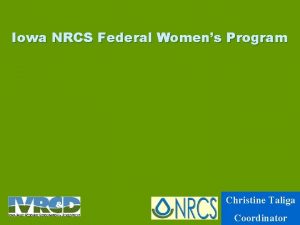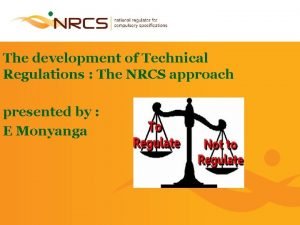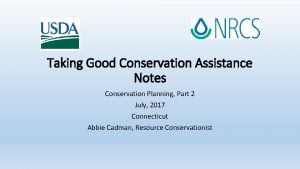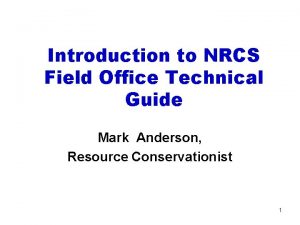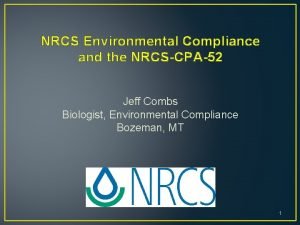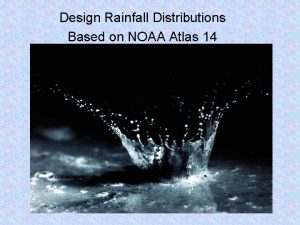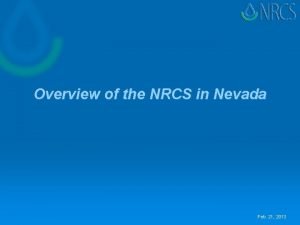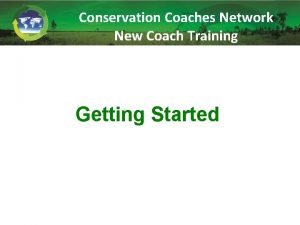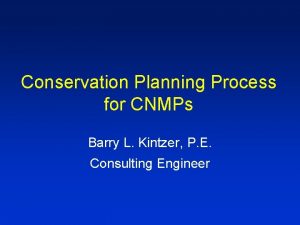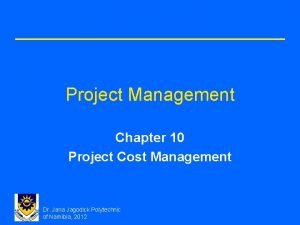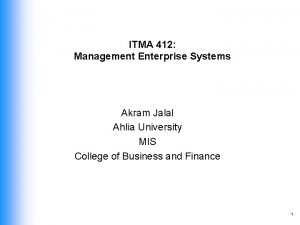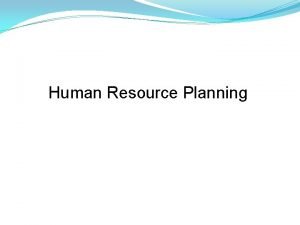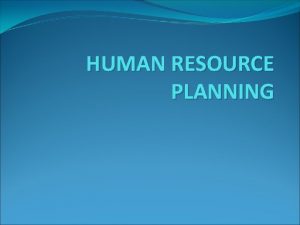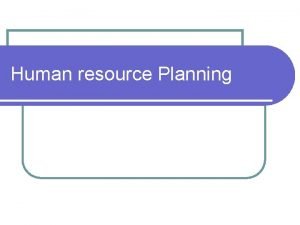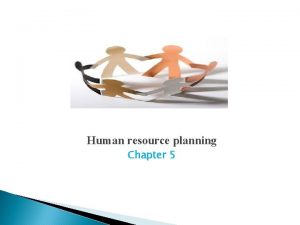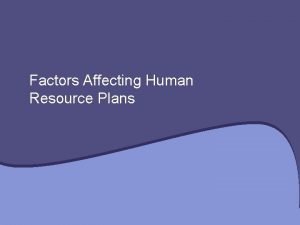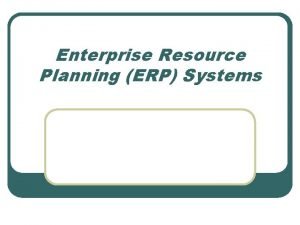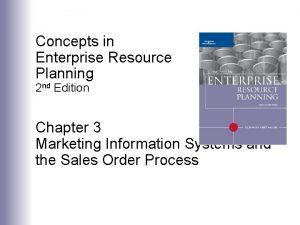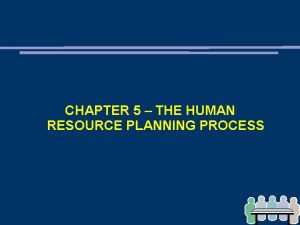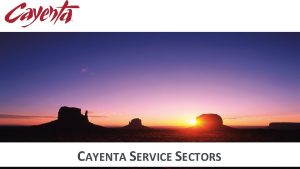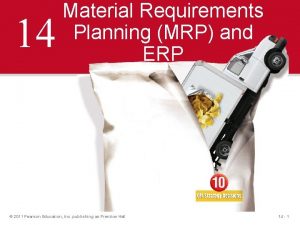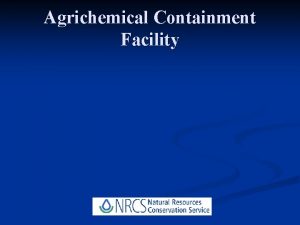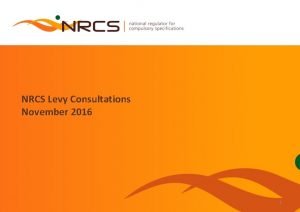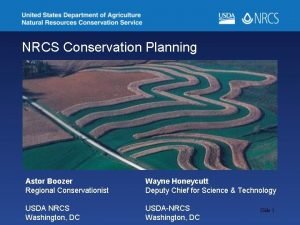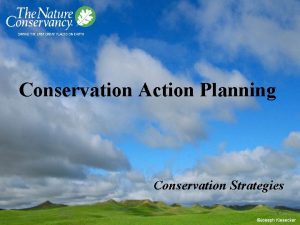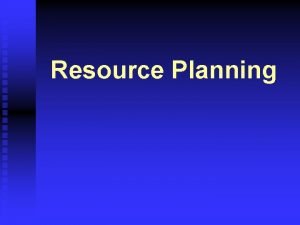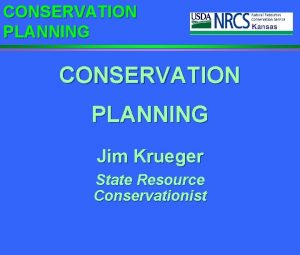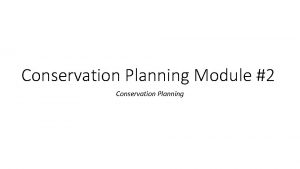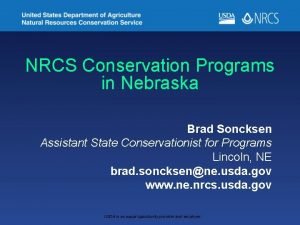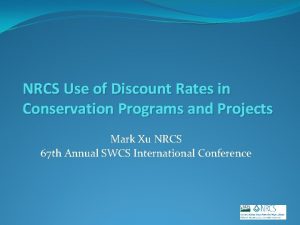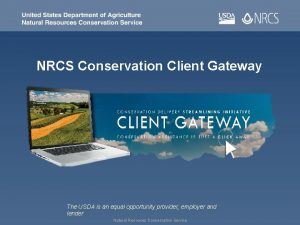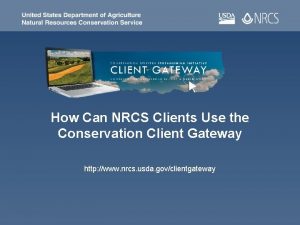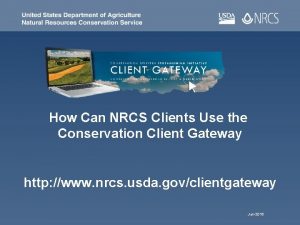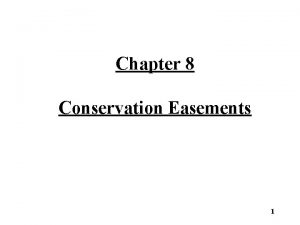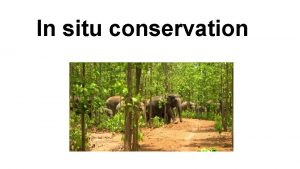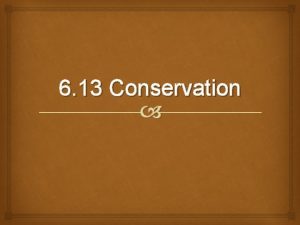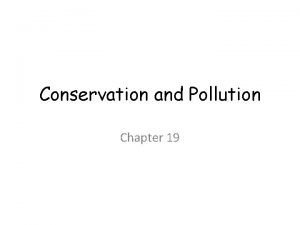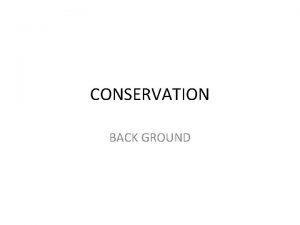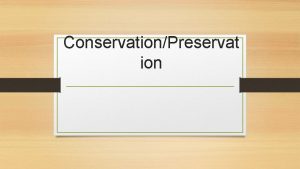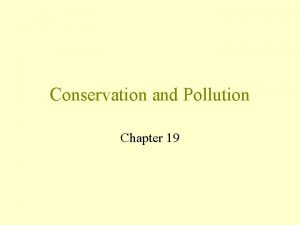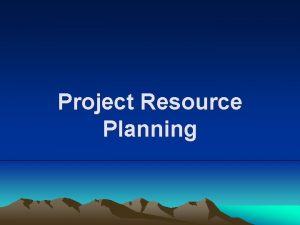NRCS Changes FY 20 Conservation Planning New Resource




































- Slides: 36

NRCS Changes FY 20 Conservation Planning: *New Resource o Concerns *New Assessment tools *New computer database (CART) Mission Support Services Operations Associate Chief Area November 2019

What is CART? • Conservation • Assessment • Ranking • Tool 2 Set of Business Practices to streamline • Conservation Planning and • Program Delivery to increase Efficiency • Program Neutral Any USDA Conservation Program!

How does CART work? Outcomes: Nationally, NRCS reported 2, 074, 000 acres with implemented cover crop practice in FY-2018 1% increase in OM saves 27, 500 gallons water/acre Nationally, NRCS cover crop practice Assisted Producers in storing 784 million gallons of water! 3

Ex. WEPS Ex: Technical Notes Ex: Photo 5 Predictive models (WEPS, Win. PST…) will still be necessary to design practices and complete implementation requirements for some practices. Mission Support Services

How does CART work? • CART uses approved assessment methodologies (of NPPH), with variable geospatial thresholds where possible, to document planning criteria. Conservation Practice thresholds consider CPPE and planning criteria. Resource Concerns * Planning Criteria 22 x 25 6 Observation Procedural/ Deductive Predictive CART Geospatial Threshold Example Tools 11 x x 14 PCS, SVAP 2 6 IET, WEPS * Total is greater than 47 because some resource concerns have different methods by land use • 47 Resource Concerns and 7 Land Uses = 329 Combinations 6 • Predictive Tools = 32 Combinations

NEW resource concerns, NEW Standards, MINOR edits to existing: Soil: 47 urce Reso erns … Conc H NPP sion Revi Soil organism habitat loss or degradation Aggregate instability Water: Surface water depletion Ground water depletion Natural available moisture use Nutrients transported to surface water (Was excess nutrients in surface water) Nutrients transported to ground water (Was excess nutrients in surface water) Air: Emission of airborne reactive nitrogen Animals: Terrestrial habitat for wildlife and invertebrates Aquatic habitat for fish and other organisms (Was inadequate habitat for fish and wildlife) Inadequate livestock water quantity, quality, and distribution (Was inadequate livestock water) 7

However…Planning Criteria is now normalized in the CART conservation practice threshold values. Which Nutrient? How do we assess and quantify? 8

Thresholds are points assigned to conservation practices. 9

How does CART Work? 10

How does CART Work? – Planning Steps 1 -6 Steps 1&2 11 Steps 3&4 Steps 5&6

How does CART work? => Steps 1 and 2 Identify the problem Soil Erosion – Sheet and Rill – Threshold Geospatially Calculated Threshold not a Set Threshold like T=4 (Predictive from CART@ Web. Soil. Survey; not RUSLE 2. 40 12

How does CART work? => Steps 3 and 4 Soil Erosion – Sheet and Rill – Existing Conditions – Inventory Resources and Analysis Data >0. 3 13 5 5 5 40

How does CART work? => Steps 3 and 4 Soil Erosion – Sheet and Rill – Existing Practices – applied practices from NPAD or observed applied practices on-site. Inventory Resources and Analysis Data Conservation Practices Conservation Crop Rotation (328) Contour Farming (330) Cover Crop (340) Residue and Tillage Management, No-Till (329) Residue and Tillage Management, Reduced Till (345) Stripcropping (585) Terrace (600) 14 5 Conservation Practice Points 10 5 15 20 15 5 15 15 20 20 40

How does CART work? => Steps 5 and 6 Soil Erosion – Sheet and Rill – Planned Practice -Formulate Alternatives, Evaluate Alternatives Conservation Practices Conservation Crop Rotation (328) Contour Farming (330) Cover Crop (340) Residue and Tillage Management, No-Till (329) Residue and Tillage Management, Reduced Till (345) Stripcropping (585) Terrace (600) 5 15 15 Conservation Practice Points 10 5 15 20 15 5 15 20 30 50 40

Resource Concern – Soil Quality – Organic Matter Depletion 16

How does CART work? – Steps 3 and 4 Soil Quality – Organic Matter Depletion – Existing Conditions 17 51 51 51 50

How does CART work? – Steps 5 and 6 Soil Quality – Organic Matter Depletion – Existing Practices Conservation Cover (327) Conservation Crop Rotation (328) Cover Crops (340) Drainage Water Management (554) Forage & Biomass Planting (512) Forage Harvest Management (511) Integrated Pest Management (595) 51 18 15 Conservation Practice Points 50 10 15 25 30 20 10 66 66 50

Resource Concern – Water Quality – Nutrients Transported to Surface Water 19

How does CART work? – Steps 1 and 2 Water Quality – Nutrients Transported to Surface Water – Threshold Each PLU will have the PLU soil runoff potential determined. Each soil map unit within the PLU will be categorized into one of four soil runoff potential classes through the Water Quality Management Services - Soil Runoff, based on its published map unit components. This service utilizes the NRCS published soils database (SSURGO). 20 Geospatially Calculated Threshold = 25 25

How does CART work? – Steps 3 and 4 Water Quality – Nutrients Transported to Surface Water – Existing Condition 21 10 11 21 21 25

How does CART work? – Steps 5 and 6 Water Quality – Nutrients Transported to Surface Water – Existing & Planned Practices Conservation Practices Filter Strip (393) Nutrient Management (590) Residue and Tillage Management, No-Till (329) Residue and Tillage Management, Reduced Till (345) 22 10 11 Conservation Practice Points 8 14 14 11 21 14 35 25

Resource Concern – Plant Degradation – Plant Structure and Composition - Forestry 23

How does CART work? – Steps 1 and 2 Plant Degradation – Plant Structure and Composition - Forestry - Threshold Each PLU forest will have a threshold value of 50 set and a benchmark condition set of questions. 24 50

How does CART work? – Steps 3 and 4 Plant Degradation – Plant Structure and Composition - Forestry – Existing Conditions 25 20 20 20 50

How does CART work? – Steps 5 and 6 Plant Degradation – Plant Structure and Composition - Forestry – Planned Practices Conservation Practices Brush Management (314) Forest Stand Improvement (666) Herbaceous Weed Treatment (603) Conservation Practice Points 10 20 10 Tree & Shrub Establishment (612) 20 26 20 20 40 60 50

Resource Concern – Plant Degradation – Plant Structure and Composition - Range 27

How does CART work? – Steps 1 and 2 Plant Degradation – Plant Structure and Composition – Range-Threshold Each PLU for range will have a threshold value of 50 set and a benchmark condition set of questions. 50 28

How does CART work – Steps 3 and 4? Plant Degradation – Plant Structure and Composition - Range Existing Conditions 29 51 51 51 50

How does CART work? – Steps 5 and 6 Plant Degradation – Plant Structure and Composition - Range Existing & Planned Practices Conservation Practices Brush Management (314) Herbaceous Weed Treatment (603) Prescribed Grazing (528) Conservation Practice Points 30 30 30 Grazing land Mechanical Treatment (548) 15 51 30 81 50

How does CART work? => Steps 3 and 4 CART assists planners to analyze resource data captured in the inventory and compare against the threshold to determine if planning criteria is met. Planner override will be allowed with supervisor approval. Threshold Existing Practices Threshold Planning Criteria 31 Existing Condition

How does CART work? – Steps 3 thru 6? CART assists planners illustrate various alternative practices to meet planning criteria and show the conservation practices effect on treating the resource concern. BONUS: Ranking taking place in background 32 Threshold Existing Practices Existing Conditions Planned practices – going into a contract

CART Workflow Configured Prior to Workflow Conservation Planning and Assessment Resource Concern, Practices, and Points Assessment Question Configuration • Geospatial • Questions Spending Plan and line items Program Manager Configuration of Ranking Pools • Geospatial • Questions Key CPDES CART FM Request For Assistance – Client Info and Field Visits conducted – typical Conservation Planning. Planner Pre-Screens Conservation Planning: 1. Prioritization Applications 2. Inventory Assessment Planner Creates Schedule • Pick PLUs Planner Creates Assessment • Select RC • Assess Existing Condition including Existing Practices • Select New Practice • Planner Override • Collect Special Concerns Info • Complete Assessment • Client Decision Planner Ranks Assessment Practices • Identify applicable Ranking Pools • Score Priority Questions • Finalize Score • Estimate Cost by Ranking Pool Planner Completes Plan • Digitizes Practices • Contract Wizard Program Manager selects and approves applications Planner Finalizes Contract CPA-52 Key CART CPA-52 CD Protracts

How does CART work? – Step 7 • CART will integrate with Conservation Desktop (CD) to turn the client’s decision into a written conservation plan. • Implementation requirements and job sheets; designs of the conservation practice will continue to be a separate part of the producer file. 34

CART Advantages • • Streamlined Assessment – Geospatial data and giving credit for previous conservation; existing conditions/ existing consevation practices • Reduced data duplication • Assessment and Resource Concern information by Land Unit • Program Prioritization based on Planning • Outcomes defined by environmental benefit. 35

Thank you! 36

"The U. S. Department of Agriculture (USDA) prohibits discrimination in all its programs and activities on the basis of race, color, national origin, age, disability, and where applicable, sex, marital status, familial status, parental status, religion, sexual orientation, genetic information, political beliefs, reprisal, or because all or a part of an individual's income is derived from any public assistance program. (Not all prohibited bases apply to all programs. ) Persons with disabilities who require alternative means for communication of program information (Braille, large print, audiotape, etc. ) should contact USDA's TARGET Center at (202) 720 -2600 (voice and TDD). To file a complaint of discrimination write to USDA, Director, Office of Civil Rights, 1400 Independence Avenue, S. W. , Washington, D. C. 20250 -9410 or call (800) 795 -3272 (voice) or (202) 720 -6382 (TDD). USDA is an equal opportunity provider and employer. "
 Nrcs 9 steps of conservation planning
Nrcs 9 steps of conservation planning Elizabeth mulroney
Elizabeth mulroney Examples of physical change
Examples of physical change Conservation ethics
Conservation ethics Iowa nrcs directory
Iowa nrcs directory Nrcs south africa
Nrcs south africa Nrcs cpa 6
Nrcs cpa 6 Wascob
Wascob Nrcs fotg
Nrcs fotg Nrcs cpa 52
Nrcs cpa 52 Noaa atlas 14
Noaa atlas 14 Aglearn login
Aglearn login Nrcs nevada
Nrcs nevada Resource loading vs resource leveling
Resource loading vs resource leveling Perbedaan antara resource loading dan resource levelling
Perbedaan antara resource loading dan resource levelling Strategic conservation planning
Strategic conservation planning Nine steps of conservation planning
Nine steps of conservation planning Planning for choices and changes
Planning for choices and changes Planning for choices and changes
Planning for choices and changes Chapter 10 animal farm summary
Chapter 10 animal farm summary Bring proff
Bring proff Forecasting techniques in hrm
Forecasting techniques in hrm Resource and cost planning
Resource and cost planning Enterprise resource planning example
Enterprise resource planning example Example of short term human resources
Example of short term human resources Meaning of human resource planning
Meaning of human resource planning Human resource planning meaning
Human resource planning meaning What is human resource planning definition
What is human resource planning definition 5 stages of human resource planning
5 stages of human resource planning Human resource management past papers and answers
Human resource management past papers and answers Factors affecting human resource planning
Factors affecting human resource planning Enterprise resource planning overview
Enterprise resource planning overview Enterprise resourse planning systems
Enterprise resourse planning systems Concepts in enterprise resource planning
Concepts in enterprise resource planning Forecasting techniques in human resource planning
Forecasting techniques in human resource planning Cayenta enterprise resource planning
Cayenta enterprise resource planning Lot sizing techniques in mrp
Lot sizing techniques in mrp
